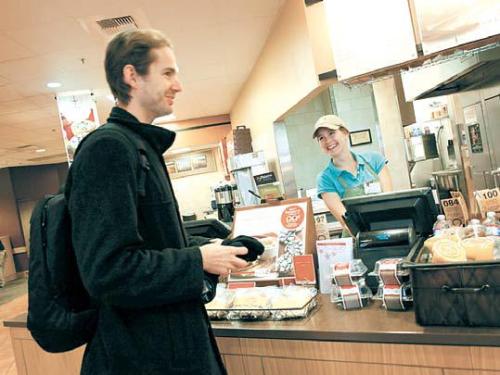LOS ANGELES ― Fast-food eateries are in the throes of drive-through Darwinism as more upscale upstarts, such as Chipotle Mexican Grill and Panera Bread Co., grab market share from the likes of Taco Bell, Subway and Wendy’s.
Chains that are fancier than fast-food options but cheaper than sit-down alternatives are part of a hybrid sector known as fast-casual that is maturing into one of the food industry’s strongest.
That category is tapping into growing demand for more healthful, specialty foods that are still speedily served and moderately priced. Fast-casual is steadily poaching fast-food customers looking for better quality and sit-down diners seeking cheaper prices, NPD analyst Bonnie Riggs said.
“There’s no end in sight to their growth,” Riggs said. “They’ve delivered on consumers’ value expectations far more than most fast-food places.”
The evolution is happening as the rest of the restaurant industry fights for a shrinking customer base amid a slow economic recovery and high food prices.
Fast-casual is still only a small segment of the industry. But it tripled its market share in roughly the past decade to about 6 percent of restaurants and is the industry’s only segment to grow in the past five years, analysts said. In 2010, major fast-casual chains pulled in $18.9 billion ― a 6 percent increase, according to research group Technomic.
Chains that are fancier than fast-food options but cheaper than sit-down alternatives are part of a hybrid sector known as fast-casual that is maturing into one of the food industry’s strongest.
That category is tapping into growing demand for more healthful, specialty foods that are still speedily served and moderately priced. Fast-casual is steadily poaching fast-food customers looking for better quality and sit-down diners seeking cheaper prices, NPD analyst Bonnie Riggs said.
“There’s no end in sight to their growth,” Riggs said. “They’ve delivered on consumers’ value expectations far more than most fast-food places.”
The evolution is happening as the rest of the restaurant industry fights for a shrinking customer base amid a slow economic recovery and high food prices.
Fast-casual is still only a small segment of the industry. But it tripled its market share in roughly the past decade to about 6 percent of restaurants and is the industry’s only segment to grow in the past five years, analysts said. In 2010, major fast-casual chains pulled in $18.9 billion ― a 6 percent increase, according to research group Technomic.

“This category has essentially blown through the recession without skipping a beat,” Technomic Executive Vice President Darren Tristano said in a statement.
Formerly known as adult fast food, fast-casual generally includes restaurants that have limited table service and no drive-thrus. They are also often perceived to have higher-end decor, food quality and prices.
But the boundaries are blurring. Eateries such as Carl’s Jr., with its Six Dollar Burger, and foodie favorite In-N-Out straddle the line between fast-casual and fast food.
Drive-thrus are appearing at Panera locations. Some fast-casual chains are experimenting with delivery, usually an option provided by sit-down restaurants.
“We’re going to continue to see more fuzziness in how to define these restaurants,” said Robert L. Sandelman, chief executive of food service research group Sandelman & Associates.
Panera, which has about 1,500 outlets nationwide, is turning in especially impressive numbers. In the third quarter its profit was $28.8 million, up 27 percent compared with the same period in 2010. In late November, the company’s stock price hit a 52-week high of $143.38.
On days when Rancho Cucamonga, Calif., resident Jason Seliskar, 38, doesn’t have time to cook, he and his wife swing by Panera.
“We can get in and get out and still have a relatively nice experience,” the elementary school teacher said. “I can walk away without thinking I gave myself a gut bomb and damaged my body.”
Bakery-cafe restaurants, such as Corner Bakery Cafe, are leading the fast-casual charge, analysts said, followed by so-called better-burger chains such as Five Guys, the Counter and the Shake Shack.
Other fast growers include Asian restaurants, noodle shops and Mexican eateries.
Perceived food quality is key to fast-casual’s rise, according to a survey measuring meal quality by the MarketForce research firm. Customers ranked Panera, Chipotle and Five Guys high while pushing fast-food companies Burger King, McDonald’s and Taco Bell to the bottom.
In the same study, fast-casual restaurants also scored among the best for atmosphere, healthful options and eco-friendly business practices.
BurgerFi, a Florida-based chain, and French chain Planetalis, which opened its first U.S. location in downtown Los Angeles in December, have vegetarian burgers and decor made with recycled materials.
Chipotle recently released popular advertisements touting family farms and emphasizing sustainable and humane practices.
Fast-casual chains also tend to have distinctive decor, such as the international-cafe feel of the Cosi sandwich chain and Pei Wei Asian Diner’s glossy vibe.
“These restaurants offer a more pleasant experience ― unlike a fast-food place that’s less clean than you’d like it to be, smelling like grease and small too,” said Jason Moser, a restaurant analyst for Motley Fool. “It’s just the evolution of eating out in general.”
Fast-food chains are far from helpless. McDonald’s, for example, continues to see hefty revenue.
But many chains are feeling the heat. Wendy’s Chief Executive Emil Brolick recently spoke of his company going through an “identity crisis.”
“I’m not for a moment suggesting that we want to try to pretend to become a Five Guys or a Smashburger or something like that,” Brolick said on a call with analysts. “But I do believe that there is a significant opportunity in the market for high-quality products that are fresh and made to order.”
By Tiffany Hsu
(Los Angeles Times)
-
Articles by Korea Herald




















![[Today’s K-pop] BTS pop-up event to come to Seoul](http://res.heraldm.com/phpwas/restmb_idxmake.php?idx=642&simg=/content/image/2024/04/17/20240417050734_0.jpg&u=)